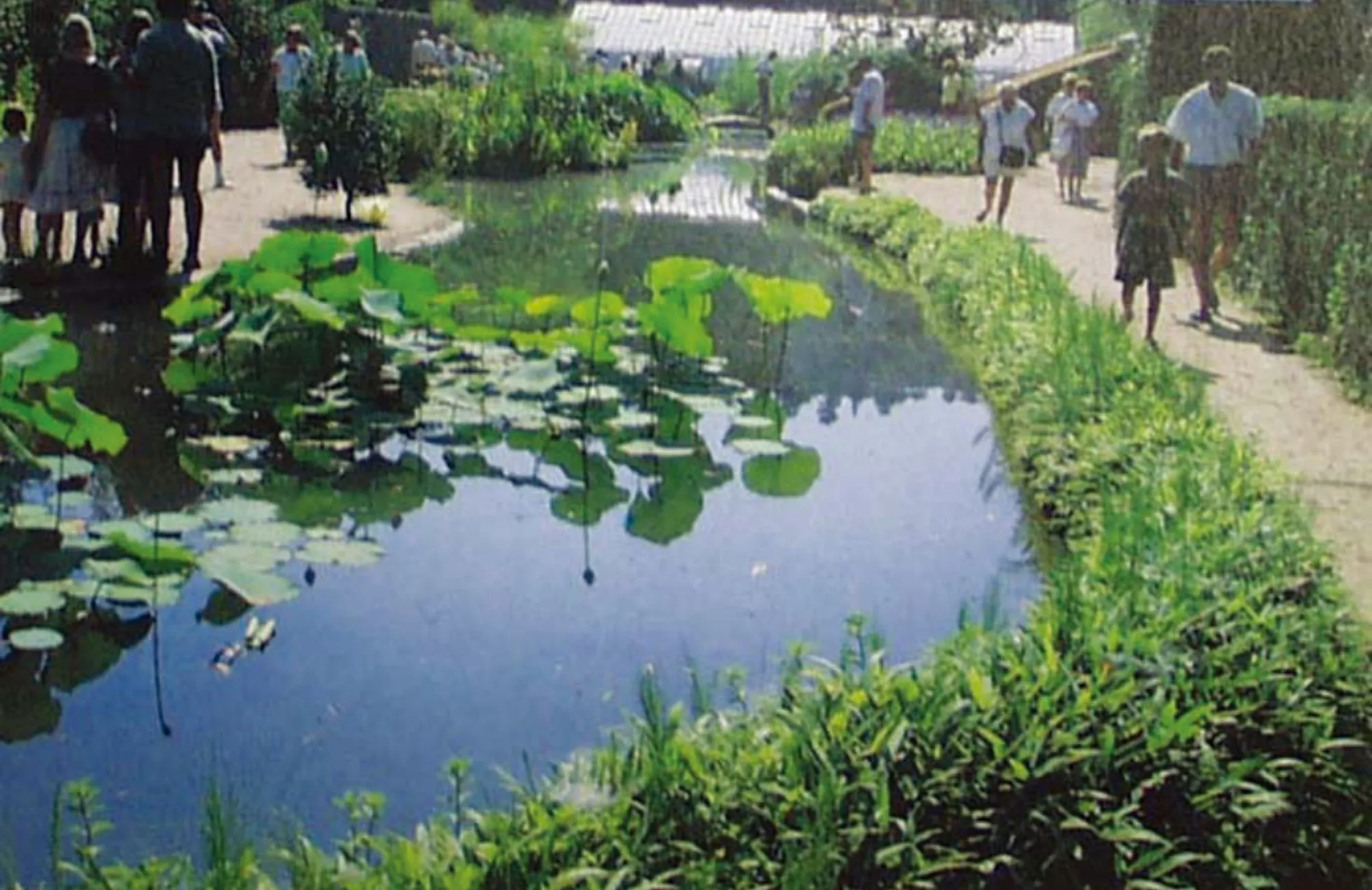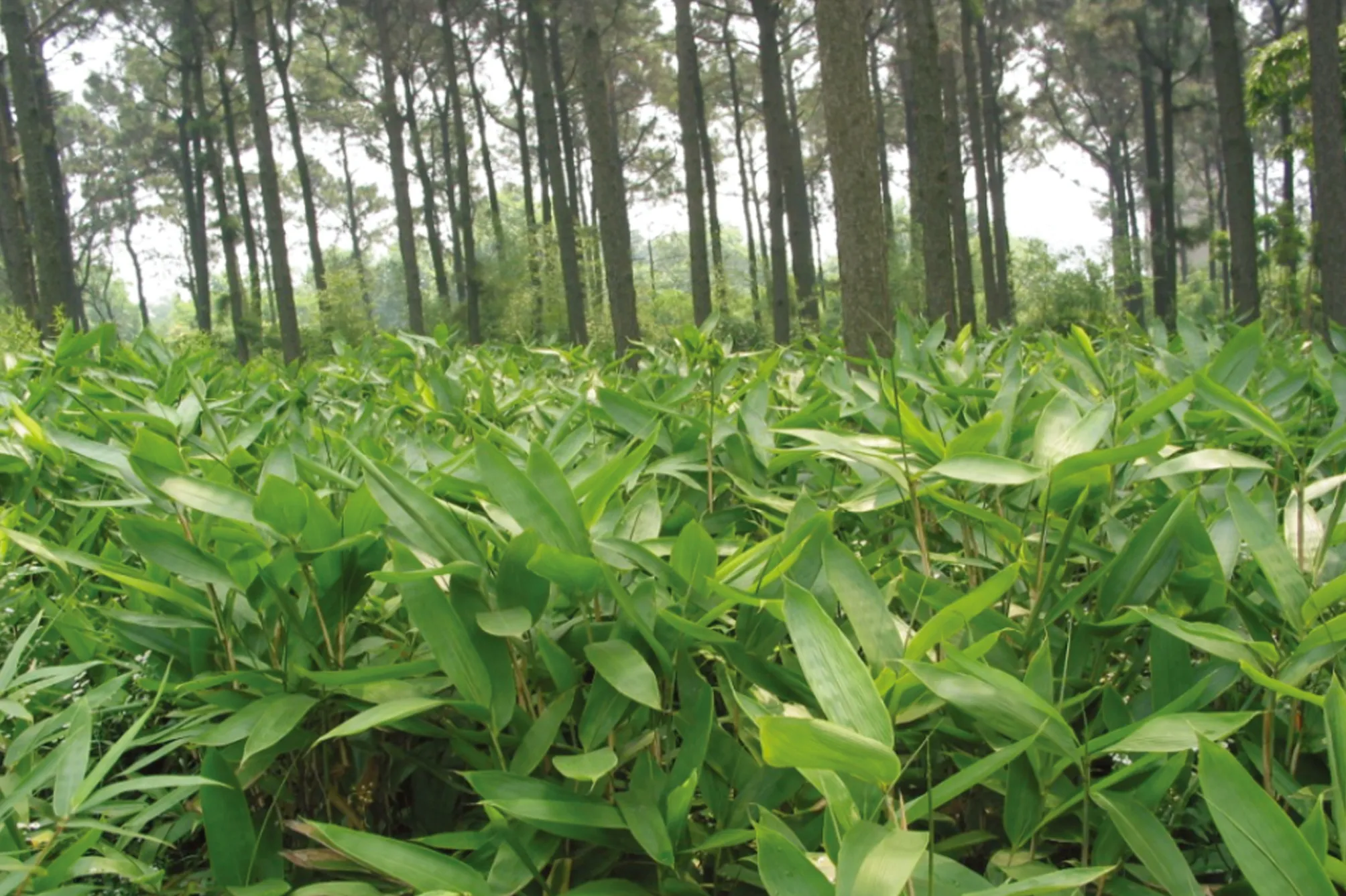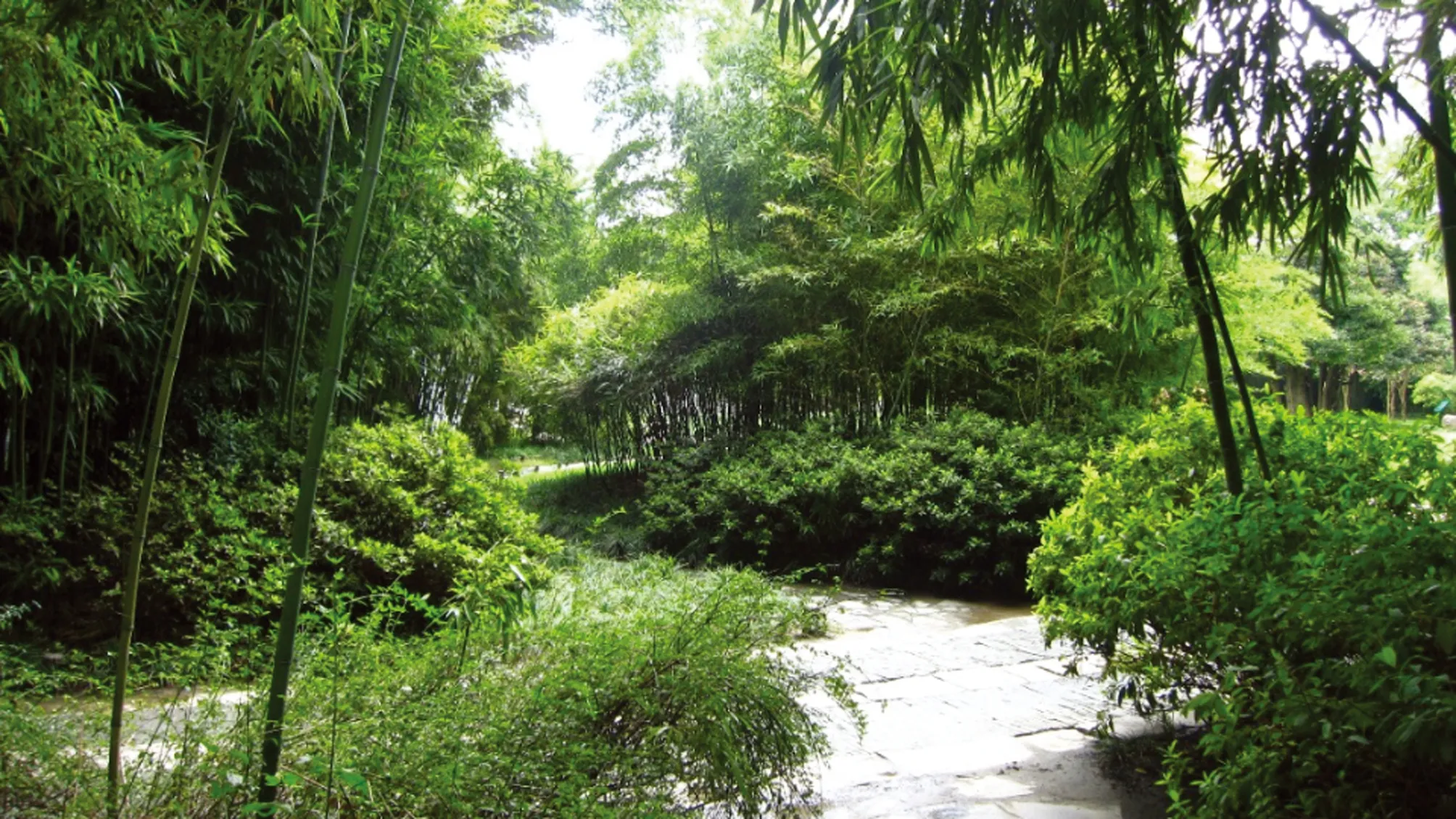Landscape Advantages and Application of Groundcover Ornamental Bamboo
2021-06-30YunZHAO
Yun ZHAO
Beijing Jingzhu Ecological Environment Co., Ltd., Beijing 100101, China
Abstract Due to the high ecological benefits, economic benefits, social benefits and cultural benefits, bamboo plays an increasingly prominent role in landscape architecture and has enormous development potential. Groundcover ornamental bamboo plays an irreplaceable role in modern urban garden landscaping, and it can form a variety of application modes with other landscape elements to create a unique landscape effect. This article analyzes the application advantages of groundcover ornamental bamboo in garden landscape, and puts forward five application modes of groundcover bamboo in garden landscape, so as to provide certain reference for urban landscaping.
Key words Ornamental bamboo, Groundcover bamboo, Garden landscaping
1 Introduction
Bamboo plants are verdant and green in all seasons. Their hollow stems symbolize modesty. They are afraid of frost and snow. Such beauty of bamboo has reached a high degree of integration with the cultural connotation and spiritual virtues of the Chinese nation. Bamboo is a "symbol of oriental beauty", and people praise China as "a country of bamboo culture." Due to their special beauty, bamboo plants have become the most distinctive and indispensable materials for landscaping in Chinese gardens. Groundcover ornamental bamboo refers to small bamboo species with a height of 30-50 cm. These bamboo plants are short but grow luxuriantly; their shoot emerging capacity and new branch growth ability are strong, the leaf shape is beautiful; they are shade and pruning tolerant, can replace lawns and flowering shrubs, and are widely used in landscaping.
2 Landscape advantages of bamboo
China has a long history of the application of bamboo in gardens. Bamboo gardening activities began as early as the Zhou Dynasty, and there were records of introduction and cultivation of bamboo in the pre-Qin Dynasty. According toRecords
of
Collecting
Relics
by Wang Jia, when starting founding Xuming Terrace, Emperor Qin Shihuang ordered searching treasures of all areas, and obtained Yungang bamboo. Then Yungang bamboo from Shanxi Province was introduced as treasure to Palace Gardens of Xianyang. During the Tang and Song dynasties, "pine, bamboo, and plum" were called "Three Friends of Winter", and "plum, orchid, bamboo, and chrysanthemum" were reputed as "Four Gentlemen or Four Noble Ones" in the Ming Dynasty, indicating that bamboo was a common garden plant at that time. In the Qing Dynasty, there were many masterpieces of bamboo planting in landscaping, and bamboo became one of the characteristics of gardens on the Yangtze Delta. In summary, bamboo has unique advantage in landscaping.2.1 Rapidly forming a landscape
After the bamboo is planted, it can rapidly grow to woods to form a landscape. The diameter at breast height of landscape bamboo is generally less than 10 cm, and it is relatively uniform, and the height of the bamboo canopy is relatively stable. After planting, it depends on the rhizome shoots to increase the plant numbers, rather than depending on height and thickness of individual plant, like trees. After planting, bamboo plants generally take 3-5 years or 7-8 years to form landscape.2.2 Strong landscape adaptability
Most bamboos are heliophilous bamboo species, but they are also relatively shade-tolerant, resistant to drought and barrenness, and have strong ecological adaptability. Adapt bamboo to the local conditions, and choose suitable bamboo species in different cities, and plant and maintain them in accordance with scientific requirements to ensure their survival rate and landscape effects.2.3 High economic benefits
One time of bamboo afforestation can achieve sustainable use, and the continuous production of bamboo shoots, bamboo seedlings and bamboo materials will obtain high economic benefits. After bamboo afforestation, the thinned bamboo poles during garden management and protection can be used as various materials; the thinned bamboo seedlings can be used for greening materials or potted plants; most of the bamboo shoots of scattered bamboo are edible and delicious. In the planning and design, if the materials, shoots, ornamental and special bamboo species are arranged in a proper manner, it is feasible to obtain high economic benefits.2.4 Enormous ecological benefits
Bamboo woods have good functions of conserving water and soil, conserving water sources, preventing wind disasters, regulating climate, purifying air, and reducing noise, and play an important role in improving the ecological environment, so bamboo afforestation has enormous ecological benefits.2.5 Profound cultural connotation
The bamboo symbolizes noble men in Chinese culture. It is humble and elegant, not afraid of the frost and snow, and high and upright in character, and symbolizes the integrity of the Chinese nation. In recent years, ornamental bamboo has been widely used in urban landscaping, urban and rural courtyard greening, indoor green decoration, and ecological environment construction. Compared with other garden plants, bamboo used in garden landscaping has immense cultural charm and can better reflect China’s cultural self-confidence.3 Groundcover ornamental bamboo and its landscape application characteristics
Groundcover ornamental bamboo refers to some low shrub-type bamboo plants that have a certain expansion ability and can quickly cover the ground. They have various types such as pole-ornamental, leaf- ornamental, and bush-ornamental types. Groundcover bamboo is characterized by easy reproduction, strong covering power, strong adaptability and extensive maintenance and management. After afforestation, groundcover bamboo can be maintained year after year without frequent replacement. Ground cover bamboos with a height of less than 1 m are suitable for groundcover plants or as lower layers in arbor forests, combined with naturally scattered ornamental stones, which are extremely natural and elegant. Some types of flowers and leaves can also be used for color matching, such asPleioblastus
fortunei
(dwarf white-stripe color),Pleioblastus
viridistriatus
(bright yellow color),Sasaella
glabraf
.albo-striata and so on. Nanjing Forestry University has introduced and bred some small bamboo species that are about 50 cm in height, beautiful in color, resistant to pruning, trampling, and have wide application, and can replace lawns and flowering shrubs. They have well-developed rhizome shoots, strong anti-scouring ability, strong water and humidity resistance, strong shade tolerance, and few pests and diseases. Their standing bamboo density is up to 1 500 plants/m, so they have excellent landscaping effects.In addition to excellent landscaping effects, groundcover ornamental bamboos also have good ecological and environmental protection functions. Bamboos have a huge underground rhizome shoots system, so they can play a strong role in soil consolidation, water retention, and slope protection; bamboo forest barriers have good wind and disaster resistance. The groundcover bamboo has dense branches and leaves, grows rapidly, and is evergreen in all seasons, and can effectively cut off noise and reduce wind speed. Bamboo plant has a high leaf area index and strong photosynthesis ability. Bamboos of the same area can release 35% more oxygen than other trees. Bamboo forests also improve the water and humidity conditions of the surrounding environment, cooling, humidifying, and regulating the microclimate. At present, the groundcover ornamental bamboos used for ornamental and landscaping mainly includeSasa
pygmaea
(Miq.) E.-G. Camus,P.
viridistriatus
,P.
fortunei
, andSasa
argenteastriatus
,etc.
The breeding and promotion of groundcover ornamental bamboo has broad development prospects. At present, Jiangsu, Shanghai, Zhejiang and other economically developed provinces have used groundcover ornamental bamboo in river bank protection, highway slope protection, square planting afforestation, green island land afforestation, and potted landscaping.4 Application modes of groundcover ornamental bamboo in garden landscaping
In landscaping, groundcover ornamental bamboo can not only be used as groundcover plants to cover the ground, but also can be used as a decoration before the scenery or as matching scenery, and can also be used as a filling material (color block) or inlay or green space for flower beds. According to the needs of garden landscape design, the groundcover bamboo with different ornamental characteristics and other landscape elements can be arranged properly to create different landscape characteristics.
4.1 Combining stones and bamboos to show firmness and gentleness and complement each other
"Mountain is static, but if there is water in the mountain, the mountain will like move; stones are hard, but if there are trees amongst the stones, the stones will become vigorous." If a large garden is arranged with undulating hills and mountains, if the mountains are covered with bamboos in various shapes and forms, we can see the scene of "green mountains and green trees" from a distance. Entering the forest, there will be a realm of elegance, tranquility and "a way out in the end". Even in the small garden space, there is no lack of exquisite rockery and stone placement, which are arranged with bamboo to form a bamboo and stone landscape, rigid and soft, vigorous and tranquil, depending on each other and complementing each other (Fig.1).
Fig.1 Combining stones and bamboos to show firmness and gentleness and complement each other
4.2 Coupling water and bamboo to show shimmering waves and bamboo shadows, protect slope and prevent soil erosion
Water is the eye of a garden. Bamboo is evergreen all year round. The combination of the two achieves the feeling that the water is much clearer and the bamboo is also much greener. Bright eyes and graceful eyebrows are characteristics of a beauty. To make the garden water more beautiful, the bamboo in the garden is like its "eyebrow". It can not only highlight the water landscape, but also activate the reflection in the water, enrich the space and color of the water surface. It is the medium for the integration of the water surface and the land, and it can also protect soil and retain water, and protect the slope (Fig.2).

Fig.2 Coupling water and bamboo to show shimmering waves and bamboo shadows, protect slope and prevent soil erosion
4.3 Using as hedges to achieve evergreen effect and beautify the environment
As hedges, bamboo plants have the functions of enclosing the land, reducing noise, wind speed and dust, purifying the air, adjusting the climate, concealing the building foundation, increasing the green landscape, and beautifying the environment. According to different landscape uses, bamboo hedges can be formed into shaping hedges, natural hedges, and semi-natural hedges. The selection of bamboo species as hedges depends on the purposes, planting location and planting environmental conditions (Fig.3).
Fig.3 Bamboo concealing the building foundation to show firmness and softness
4.4 Planting bamboos under forest to cover the bare land and form a multi-level landscape
Planting groundcover bamboos under forests can cover bare land in open spaces, prevent the formation of mud and sand, increase vegetation coverage, increase species diversity, and form a multi-level landscape, and also prevent weeds from breeding and avoiding human entry and trampling. Bamboo species used as groundcover bamboos under forest should have the following characteristics: shade tolerance, luxuriant growth, strong shoot emerging capacity and new branch growth ability, and dwarf plants.S.
pygmaea
(Miq.) E.-G. Camus,P.
viridistriatus
,P.
fortunei
, andS.
argenteastriatus
of genus Sasa makino et Shibata are the most suitable groundcover ornamental bamboo species. Their leaf shape is beautiful, and the leaves have colorful stripes, which are extremely ornamental (Fig.4).
Fig.4 Planting bamboos under forest to cover the bare land and form a multi-level landscape

Fig. 5 Three-dimensional landscape created by medium-high ornamental and groundcover bamboos
4.5 Arranging multiple bamboo species to highlight the ornamental characteristics of different bamboo species and create a three-dimensional landscape effect
Bamboo plants have lush branches and leaves, and they will not wither and fall in winter. The three-dimensional effect of making obstructive scenery is good. For large-scale public green space gardens, the obstructive scenery can adopt tall bamboo species of the genus Phyllostachys and arbor and other tree species; in small courtyards, medium-high ornamental bamboos can be combined with groundcover bamboos (Fig.5), or bamboo species of different colors can be staggered to create a colorful landscape effect.5 Conclusions
Bamboo is a natural resource and has cultural heritage, and it
is a landscape plant with unique advantages. Due to high ecological benefits, economic benefits, social benefits and cultural benefit, and with the advance of national strategies such as "ecological civilization construction", "beautiful China", and "Two Mountains Theory" (lucid waters and lush mountains are invaluable assets), the unique role of bamboo in the garden landscape will become increasingly prominent, and its development potential is enormous. Groundcover ornamental bamboo plays an irreplaceable role in modern urban garden landscaping, and it can form a variety of application modes with other landscape elements to create a unique landscape effect. In summary, selecting and promoting groundcover ornamental bamboo suitable for different regions, especially the climatic conditions in the northern region, is of great significance for enriching the landscape plant species in the northern region and enhancing the effect of the garden landscape.
杂志排行
Asian Agricultural Research的其它文章
- Digital Economy Empowers China’s Rural Revitalization: Current Situations, Problems and Recommendations
- Research Progress on Bacteriostasis of Nano Selenium
- Plant Cultivation Device in Intelligent Agricultural Greenhouse
- Reform of Teaching Mode for College Students’ Financial Literacy Training under General Education: Taking Yangtze University as an Example
